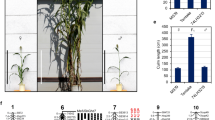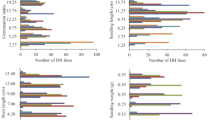Abstract
MORPHOLOGICALLY the grasses Lolium perenne and L. temulentum are markedly dissimilar and easily distinguished from one another. They differ also in habit and in their breeding system; the former is perennial and outbreeding, while the latter is an annual and inbreeding. Despite their divergencies in form and habit, the species can, however, be crossed, and hybrid plants are readily grown from seed produced when L. perenne is used as female parent. This was demonstrated by Jenkin1, who has described the hybrids in detail.
This is a preview of subscription content, access via your institution
Access options
Subscribe to this journal
Receive 51 print issues and online access
$199.00 per year
only $3.90 per issue
Buy this article
- Purchase on Springer Link
- Instant access to full article PDF
Prices may be subject to local taxes which are calculated during checkout
Similar content being viewed by others
References
Jenkin, T. J., J. Genet., 52, 300 (1954).
Thomas, P. T., Ph.D. thesis, University College of Wales, Aberystwyth (1937).
Darlington, C. D., “Recent Advances in Cytology” (1937).
Thomas, P. T., Nature, 138, 402 (1936).
Author information
Authors and Affiliations
Rights and permissions
About this article
Cite this article
NAYLOR, B., REES, H. Chromosome Size in Lolium temulentum and L. perenne . Nature 181, 854–855 (1958). https://doi.org/10.1038/181854a0
Issue Date:
DOI: https://doi.org/10.1038/181854a0
This article is cited by
-
Isozyme variation and species relationships in the genus Lolium L. (ryegrasses, Graminaceae)
Theoretical and Applied Genetics (1994)
-
Intergeneric relationships ofLolium, Festuca, andVulpia (Poaceae) and their phylogeny
Plant Systematics and Evolution (1988)
-
Chromosome evolution in Lolium
Heredity (1967)
-
Cytogenetic studies on the F1 hybrid ofLolium multiflorum ×L. rigidum and the species relationship in the genusLolium
Der Züchter (1967)
-
Nuclear Variation between Diploid Angiosperms
Nature (1966)
Comments
By submitting a comment you agree to abide by our Terms and Community Guidelines. If you find something abusive or that does not comply with our terms or guidelines please flag it as inappropriate.



